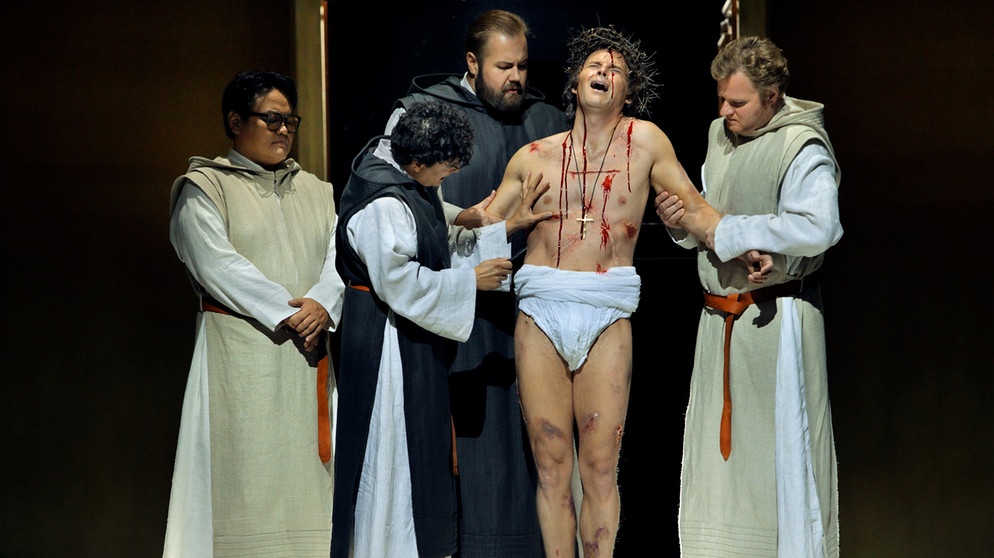Zemlinksy Lyric Symphony Prom 62, with Simone Young and the BBC Symphony Orchestra. But first, BBC researchers should wake up and realize that this symphony is NOT rare! There are numerous recordings, and many performances, including Salonen and Jurowski in London in recent years, and many others which I haven't written about. Even three previous Proms performances. Perpetuating the myth that the Lyric Symphony is a rarity is counter-productive because it fools audiences into accepting mediocrity when there are so many excellent performances to explore. This symphony is such a masterpiece that it's shameful how clichés have got in the way of insight.
Zemlinsky's Lyric Symphony was written in 1926-7, at a time of groundbreaking creative change. That the texts come from Tagore is no accident. Tagore was a literary superstar, at a time when western culture was more open to change and alien influences than ever before. The Exotic East represented new, unknown frontiers . Zemlinsky was doing what Debussy, Stravinsky and Ravel had done before him, and also drawing on a long-standing German fascination with Asia. Tagore was popular in progressive circles because his rejection of materialism ran counter to the values of a a western world that had been shaken to its foundations by war and revolution. Embracing Tagore's spirituality was a kind of liberation. By using Tagore as the basis of this symphony, Zemlinsky is doing more than adopting pseudo-oriental exoticism. Zemlinsky used a large orchestra, rich with colour and texture, not to look backwards. The ending does not represent resignation. "Ich halte meine Lampe in die Höhe, um dir auf deinen Weg zu leuchten". I hold my lamp up high to light you on your way. Zemlinsky, like the Prince, is looking forwards, toward directions unknown.
The Lyric Symphony deals with love, but it is by no means a romantic symphony: the protagonist move on, and apart. The Alma Mahler connection is also very much over-rated. So beware of heavy-handed "romantic" interpretations, more suited to Hollywood than to a key work of the 20th century. Just as Zemlinsky recognized the clear-sighted non-sentimentality in Tagore's texts, so too should performance be based on clarity and intellectual precision. Anthony Beaumont, the paramount Zemlinsky authority, without whose work Zemlinsky studies would be nowhere, wrote in his analysis of this symphony that “often the singers are engulfed in a dark forest of orchestral filigree work. In performance, the score requires Mozartian grace and precision. For all its abandon, this music reveals its true beauty and power only if performed with discipline and cool headed restraint”.
Simone Young's approach to Zemlinsky will no doubt be praised because it meets audience expectations, some shaped by unidiomatic performances and by the kind of clichés the BBC regurgitates. But audience expectations are fatal to art. A good conductor should work from the score, to find new insight, even though these days some audiences don't want change so much as processed consumer product. Young's Zemlinsky is straightforward, earthbound, without much connection to the originality of the piece. The BBC SO is far too good an orchestra to "engulf" the soloists as Beaumont warned, though at this Prom the soloists, Siobhan Stagg and Christopher Maltman, could have done with more cover from the "forest". Maltman was not on best form, his voice not quite lithe enough to finesse the trickier passages in the part. While the female voice in this symphony portrays a very young girl, youth itself is not enough. Siobhan Stagg is very young, her voice pretty enough but rather shrill at times. The Girl she's singing is made of such strong stuff that the Prince knows he's met someone who will surpass him. Nonetheless, Zemlinsky's Lyric Symphony is such a wonder that those who liked this Prom would do well to listen further, to Chailly and to Eschenbach, and pray that Salonen does it again with good soloists.
Baiba Skride was the soloist in Mozart's Violin Concerto No 5 in A major, K219, Turkish. Her playing has personality, well suited to the quirky nature of the piece. Here the BBC SO shone, rising to Skride's agile enticements.
Throughout this Proms season, there have been odd mismatches between performers and repertoire,. Though Bayan Northcott's Concerto for Orchestra, commissioned for the BBC SO, is well within their natural territory, I felt it might need time to settle It's a good piece with lots of interest, perhaps too much to absorb without many hearings, which hopefully it will receive.
Zemlinsky's Lyric Symphony was written in 1926-7, at a time of groundbreaking creative change. That the texts come from Tagore is no accident. Tagore was a literary superstar, at a time when western culture was more open to change and alien influences than ever before. The Exotic East represented new, unknown frontiers . Zemlinsky was doing what Debussy, Stravinsky and Ravel had done before him, and also drawing on a long-standing German fascination with Asia. Tagore was popular in progressive circles because his rejection of materialism ran counter to the values of a a western world that had been shaken to its foundations by war and revolution. Embracing Tagore's spirituality was a kind of liberation. By using Tagore as the basis of this symphony, Zemlinsky is doing more than adopting pseudo-oriental exoticism. Zemlinsky used a large orchestra, rich with colour and texture, not to look backwards. The ending does not represent resignation. "Ich halte meine Lampe in die Höhe, um dir auf deinen Weg zu leuchten". I hold my lamp up high to light you on your way. Zemlinsky, like the Prince, is looking forwards, toward directions unknown.
The Lyric Symphony deals with love, but it is by no means a romantic symphony: the protagonist move on, and apart. The Alma Mahler connection is also very much over-rated. So beware of heavy-handed "romantic" interpretations, more suited to Hollywood than to a key work of the 20th century. Just as Zemlinsky recognized the clear-sighted non-sentimentality in Tagore's texts, so too should performance be based on clarity and intellectual precision. Anthony Beaumont, the paramount Zemlinsky authority, without whose work Zemlinsky studies would be nowhere, wrote in his analysis of this symphony that “often the singers are engulfed in a dark forest of orchestral filigree work. In performance, the score requires Mozartian grace and precision. For all its abandon, this music reveals its true beauty and power only if performed with discipline and cool headed restraint”.
Simone Young's approach to Zemlinsky will no doubt be praised because it meets audience expectations, some shaped by unidiomatic performances and by the kind of clichés the BBC regurgitates. But audience expectations are fatal to art. A good conductor should work from the score, to find new insight, even though these days some audiences don't want change so much as processed consumer product. Young's Zemlinsky is straightforward, earthbound, without much connection to the originality of the piece. The BBC SO is far too good an orchestra to "engulf" the soloists as Beaumont warned, though at this Prom the soloists, Siobhan Stagg and Christopher Maltman, could have done with more cover from the "forest". Maltman was not on best form, his voice not quite lithe enough to finesse the trickier passages in the part. While the female voice in this symphony portrays a very young girl, youth itself is not enough. Siobhan Stagg is very young, her voice pretty enough but rather shrill at times. The Girl she's singing is made of such strong stuff that the Prince knows he's met someone who will surpass him. Nonetheless, Zemlinsky's Lyric Symphony is such a wonder that those who liked this Prom would do well to listen further, to Chailly and to Eschenbach, and pray that Salonen does it again with good soloists.
Baiba Skride was the soloist in Mozart's Violin Concerto No 5 in A major, K219, Turkish. Her playing has personality, well suited to the quirky nature of the piece. Here the BBC SO shone, rising to Skride's agile enticements.
Throughout this Proms season, there have been odd mismatches between performers and repertoire,. Though Bayan Northcott's Concerto for Orchestra, commissioned for the BBC SO, is well within their natural territory, I felt it might need time to settle It's a good piece with lots of interest, perhaps too much to absorb without many hearings, which hopefully it will receive.












